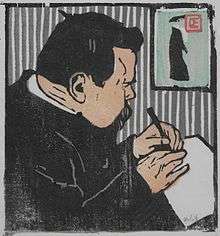Bernhard Pankok


Bernhard Pankok (Münster [Westphalia], 16 May 1872—Baierbrunn, 5 April 1943) was a modern German painter, graphic artist, architect, and designer.
Career
His works are characterized by the transition between Art Nouveau and the International Style. His furniture and book design, such as the catalog of the German section for the 1900 Exposition Universelle in Paris, have garnered him the most recognition.
Pankok opened a studio in Munich in 1892 and worked as a freelance artist, graphic designer and illustrator for the magazines Pan and Jugend. He remained in Munich until 1902 and co-founded the Vereinigten Werkstätten für Kunst im Handwerk (United Workshops for Art in Handcraft). In 1902 he moved to Stüttgart, and in 1913 he helped co-found a local art school, the Stuttgarter Killesberg, and became the its first director. (In 1927, the famous architectural exhibition, the Weissenhofsiedlung, was built nearby.) In 1907 he became a member of the newly founded German Werkbund and 1914, he figured as one of the leading artists of the famous Werkbund Exhibition in Cologne.
In 1930 he became a foreign member of the Munich Secession and in 1932 he was appointed an honorary member of the Westphalian Kunstverein Münster, a year later, the honorary member of the Academy of Fine Arts, Munich. The Academy of Fine Arts in Stuttgart appointed him an honorary member on his seventieth birthday in 1942.
Bibliography
- Hermann Gretsch, Bernhard Pankok zum Gedächtnis: Rede, gehalten anläßlich der Immatrikulationsfeier der Akademie der bildenden Künste in Stuttgart am 14. Mai 1943. Stüttgart, 1943.
- Hans Klaiber, Bernhard Pankok: Ein Lebensbild. Stüttgart: Staatliche Akademie der bildenden Künste Stüttgart, 1981.
- Wolfgang Kermer (Hrsg.), Zwischen Buch-Kunst und Buch-Design. Buchgestalter der Akademie und ehemaligen Kunstgewerbeschule in Stuttgart. Werkbeispiele und Texte. Cantz: Ostfildern-Ruit, 1996. ISBN 3-89322-893-4.
- Andrea Tietze, "Pankok, Bernhard Wilhelm Maria." In: Neue Deutsche Biographie 20, Duncker & Humblot, Berlin 2001. ISBN 3-428-00201-6, S. 32 f.
External links
- Literature by and about Bernhard Pankok in the German National Library catalogue
- Bernhard Pankok Biografie
- Möbelentwurf
- Werkbeispiele und Biographie von Bernhard Pankok in der Galerie Ostendorff, Münster